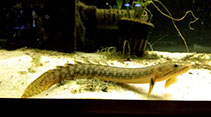| Diagnosis: |
Dorsal spines (total): 7-9; Anal spines: 12-15; Vertebrae: 55-58. Diagnosis: Polypterus retropinnis is distinguished from all other species of Polypterus except P. mokelembembe, P. ornatipinnis, P. teugelsi, P. polli and P. palmas in having a high predorsal-scale count: 26-34 vs. 11-25 (Ref. 56367). It differs from P. ornatipinnis, P. teugelsi and P. polli in having 56-59 lateral-line scales vs. 61-65 in P. ornatipinnis and P. teugelsi and 52-55 in P. polli; from P. palmas by having a single large black blotch on the pectoral-fin base vs. numerous small spots on posterior part of base; and from P. mokelembembe by having a narrower first dorsal-fin spine being 4,6-6,1% of head length vs. 6,4-8,1%, a greater internostril distance being 14,3-18,0% of head length vs. 11,6-13,7%, and more pectoral-fin rays, 30-34 vs. 23-29 (Ref. 56367). Jaws mostly about the same length, the upper jaw sometimes a little longer than lower jaw; pectoral fin not reaching dorsal-fin origin (Ref. 43035, 46852). In addition, living specimens of Polypterus retropinnis differ from all congeners in their iris coloration, which consists of creamy white areas and black dots alternating with each other around the iris; however, this character state is rarely visible in preserved specimens (Ref. 56367).
Description: Body elongate, subcylindrical, body depth 9,2-13,4% of standard length, head length 16,8-21,8% of standard length (Ref. 43035, 56367, 81628). Jaws mostly about the same length, the upper jaw sometimes a little longer than lower jaw (Ref. 43035, 46852). Eye diameter 11,0-17,7% of head length; internostril distance 14,3-18,0% of head length (Ref. 56367). Predorsal length 55.7-63.2% of standard length (Ref. 51884). Dorsal fin with 7-9 spines, followed by 13-16 dorsal and caudal articulated rays; first dorsal spine narrow, 4,6-6,1% of head length; 30-34 pectoral fin rays, pectoral fin not reaching dorsal-fin origin; 7-10 pelvic fin rays (Ref. 51884, 56367, 81628). Ganoid scales (Ref. 42904): 56-59 lateral line scales, 30-38 scales around the body, 26-34 predorsal scales, 40-46 prepelvic scales (Ref. 51884, 56367, 81628). Number of vertebrae: 55-58 (Ref. 81628).
Colouration: In alcohol, dorsally olive brown with an irregular pattern of dark brownish-black markings, ventrally uniform whitish to light beige; distally pectoral fin base with distinctive black blotch (Ref. 41580, 51884, 56367, 81628). Pectoral fin web with irregular rows of small spots; pelvic and anal fins whitish without marks; dorsal and caudal fins with lines of darker marks on a light brown to beige background; membrane of dorsal spines with black blotches basally (Ref. 81628). Snout, upper and lower lips marbled with brown lines; cheek with prominent oblique black stripe extending from below the eye to end of lower jaw (Ref. 44841, 46861, 81628). |

